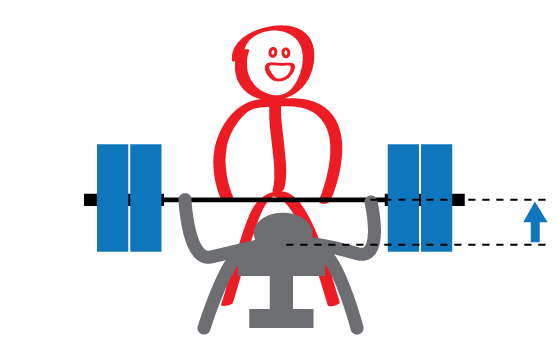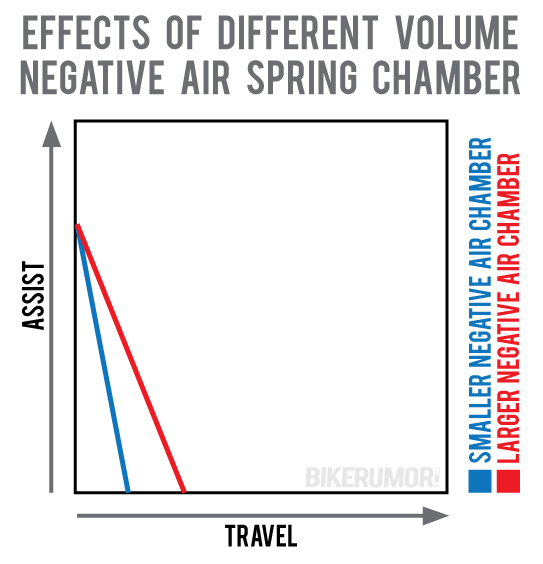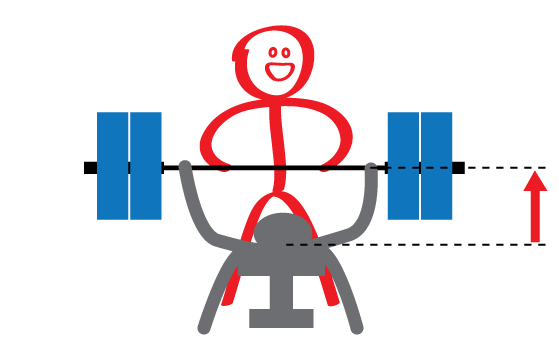No matter which brand of fork or shock you’re riding, if it uses an air spring, they all have a negative spring. Even coil-over shocks and coil-sprung forks can benefit from a negative spring, though they’re less common on mountain bikes these days (we’ll explain why). It’s more important on air-sprung suspension because it takes a lot of force to overcome a pressurized chamber and start it moving. That initial force is exacerbated by the stiction from the piston seal that closes off the positive air chamber to keep the air in. It has to be tight enough to seal even under high pressure, which adds to the force that must be overcome to begin travel. Here’s how the negative spring does that and why size matters…
Before we get into specifics, we asked a couple of brands how a negative spring affects suspension performance and why it’s there. Here’s their answers:
Nick Pye, Manitou Product Engineer, explains that “the negative spring balances the force of the positive spring when the fork is in its neutral/unloaded state. This applies to both coil springs and air springs, forks and shocks. When the fork is fully extended it is desirable to have a negative spring force equal to the positive spring force to minimize the force require to initiate fork travel. If the positive spring force exceeds the negative spring force the fork will not initiate movement until an external force is applied to the fork exceeding the differential between the positive and negative springs. Unlike a coil negative spring which has a finite length, a negative air spring applies a force during the entire stroke of the fork. As such, the net force of the positive and negative air springs is the resultant spring force of the system.”
Fox and Rockshox, however, design their air suspension such that the positive and negative chambers equalize pressure at or near sag. “On RockShox products featuring DebonAir(DB) the negative airspring matches the force created by the positive airspring at Sag (30% of travel),” says RockShox rear shock Product Manager Chris Mandell. “This allows these rear shocks to be very responsive in the initial portion of the travel to the fast and small chatter providing the rider with grip, control and confidence over a non-DB system.”
For suspension set up like that, you’ll need to cycle the suspension halfway through its travel to equalize the chamber. If you’re starting from 0psi, that means you’ll probably want to double and triple check the pressure as you’ll lose some into the negative chamber as you cycle it.

Recent product introductions from Fox and Rockshox have both included larger negative air chambers, and there’s a good reason why. Assuming equal air pressure between positive and negative chambers (which is how virtually every modern suspension part is designed to do), a smaller negative chamber will provide noticeable assistance for a shorter amount of stroke. Fox’s Mark Jordan says their prior generation forks’ negative chambers assisted through about the first 10% of travel, but the new EVOL forks stretch that to the first 25% of travel.
Think of the negative spring like a spotter on the bench press, and you’ve got just a little too much weight on the bar. The “normal” size negative air chamber would only help get the bar moving off your chest and quickly ease off the assistance.
A larger negative air spring would keep helping as you really got the bar moving, giving you just a little extra momentum before the assistance trailed off.
On the trail, this translates to a more supple mid-stroke since there’s a little more assistance further into the travel. But this is where it gets weird. Technically, the negative spring is helping all through the travel, since even at full compression, it still has a small amount of air pressure pushing against the positive spring.
But, Pye explains that “during compression the positive air chamber compresses and the negative air chamber expands. Just as it takes a force to compress the positive air volume, it takes force to expand the negative air chamber. If the negative spring volume is increased it reduces the amount force required to expand the negative air volume. This is analogous to reducing the air volume in the positive air chamber to increase end-of-stroke ramp-up; the smaller the air chamber the more force required to bottom the fork. The overall effect (of increasing the negative air spring size) on the (positive) air spring is reducing the net spring force thru approximately the first 25% of stroke.”
So, at the same time it’s helping, the system will naturally want to balance the pressures and pull itself back to equilibrium. But as Pye says, the overall effect is a good one in terms of suspension performance.
WHAT ABOUT MAKING A STRONGER NEGATIVE SPRING?
In the case of suspension, size really does matter. You don’t want it to be too strong. Mandell says the negative spring should be “balanced with your Positive airspring and the damping (Rebound and compression) the shock provides. If you make your negative airspring too strong, the shock will feel floppy and uncontrolled at the beginning of the stroke. Too weak and the bike could feel harsh at the beginning of the travel.”
Pye adds another caveat: “If the negative spring volume is decreased it increases the amount force required to expand the negative air volume. The overall effect on the air spring is increasing the net spring force thru approximately the first 25% of stroke. If the Negative spring force exceeds the positive spring force the fork would simply settle lower into the travel until the positive and negative forces are balanced.
WHAT ABOUT COIL SUSPENSION?
Manitou has several forks, like the Circus dirt jump model, that still use a coil spring and have negative springs. Fox uses it in some of their moto suspension where weight isn’t as much of a concern. Technically speaking, a coil spring benefits in exactly the same way as an air spring – the negative balances (or suppresses) the starting forces required to initiate movement. Jordan says some moto setups use it to allow them to run a firmer overall spring to provide better mid-stroke support for hard hits without giving up small bump sensitivity. Generally speaking, and especially for mountain bikes, it’s much easier to get a coil spring moving than an air spring, so we don’t often see them since weight is a more important factor.
WHAT DOES IT ALL MEAN?
In a nutshell, the negative spring helps your suspension feel more supple in the beginning of the stroke by countering (or at least balancing) the positive air spring, putting the fork or shock in a neutral, floating state that’s ready to react. Without it, air suspension would be harsh and unresponsive to small bumps and no fun to ride.
The fun never ends. Stay tuned for a new post each week that explores one small suspension tech, tuning or product topic each week. Got a question you want answered? Email us. Want your brand or product featured? We can do that, too.

